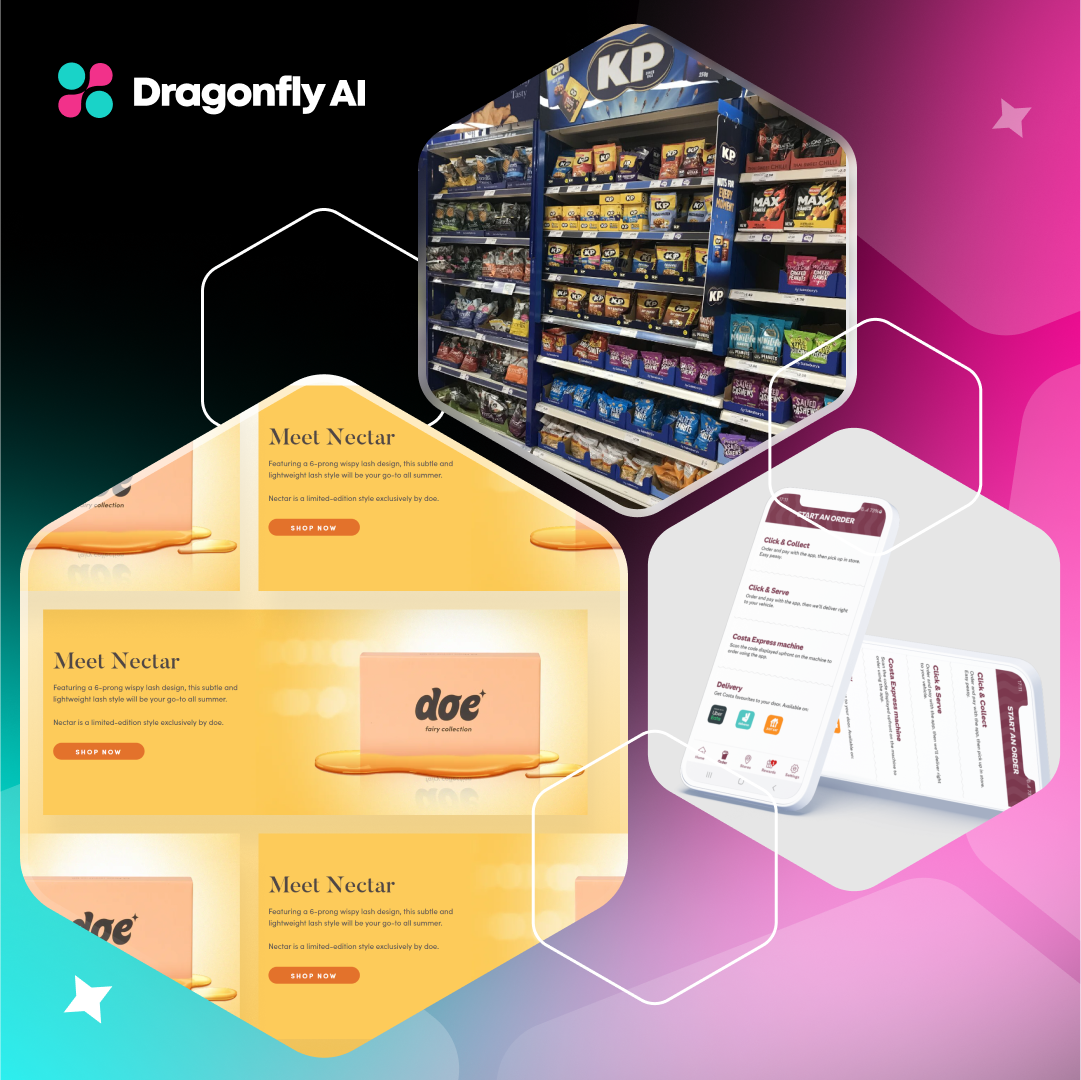other topics

Sustained Attention Secrets to Boost CPG Brand Visibility
Across the Consumer Packaged Goods (CPG) industry, capturing and maintaining your audience’s...
Ever noticed how you instantly recognize a McDonald's jingle or recall Nike’s ‘Just Do It’ slogan? That’s not by accident—it’s cognitive marketing at work.
By leveraging cognitive psychology and AI marketing, brands influence perception, memory, and decision-making to build stronger connections and increase ROI.
Cognitive marketing goes beyond catching attention—it ensures brands stay top of mind and drive long-term loyalty. By using cognitive learning marketing, brands can tailor their messaging to match consumer decision patterns, making ads more memorable than ever.
Consumers form first impressions in just 50 milliseconds. Brands that understand cognitive biases in perception can immediately position themselves in consumers’ minds:
Want to optimize perception-based marketing? AI marketing tools like Dragonfly AI can test layouts and predict consumer reactions before launching campaigns.
.png?width=731&height=400&name=Blog%20image%202%20(1).png)
For ads to work, they must be encoded in memory—a process strengthened by cognitive learning marketing.
Cognitive marketing drives action, but cognitive dissonance makes consumers hesitate. To help counteract this hesitation and increase conversions, brands use:
Cognitive marketing leverages insights from cognitive psychology to shape how consumers process, remember, and react to advertising. This approach helps brands build stronger connections with their audience, leading to higher engagement and better conversion rates.
By understanding how people think, brands can design ads, websites, and digital experiences that align with consumer expectations and decision-making patterns.
Consumers feel cognitive dissonance when unsure about a purchase. Brands reduce it by:
By using these cognitive marketing strategies, brands can create ads and digital experiences that grab attention and influence decision-making—leading to higher conversions and stronger brand loyalty.
Perception is the first step in cognitive marketing. It determines how consumers interpret ads, products, and brand messages. By using cognitive learning marketing techniques, brands can trigger emotions, capture attention, and make lasting impressions.
Sensory marketing plays a key role in shaping perception. It involves using sight, sound, and even touch to influence how people feel about a brand.
AI-powered tools, like Dragonfly AI, can analyze how consumers process visuals before a campaign launches. This helps brands:
By understanding how perception works, businesses can use cognitive marketing to design more effective campaigns that connect with consumers instantly.
Emotions do more than make ads memorable—they play a major role in cognitive marketing by shaping consumer decisions. When people associate a brand with a strong emotion, they are more likely to develop loyalty, make a purchase, and even recommend it to others.
Cognitive dissonance in marketing also plays a role here. If an ad creates a disconnect between a person’s beliefs and their actions, they may feel uneasy. This is why marketers focus on creating emotionally aligned messaging that reinforces the consumer’s existing values.
When brands successfully incorporate cognitive learning marketing principles, their ads become more than just promotions—they turn into lasting emotional experiences.
.png?width=823&height=450&name=Blog%20image%203%20(1).png)
Marketers no longer have to guess which emotions drive purchases. AI-powered tools like Dragonfly AI help brands:
By combining cognitive marketing insights with AI-driven data, brands can create emotionally compelling campaigns that not only grab attention but drive real business results.
Every buying decision is shaped by cognitive biases—mental shortcuts that help people make quick choices without overanalyzing. In cognitive marketing, brands use these biases to increase engagement and conversions without overwhelming consumers with too much information.
People tend to remember the last thing they see or hear, making end-of-ad messaging an important strategy in advertising psychology. Marketers often place discounts, key takeaways, or calls to action at the end of ads to leave a lasting impression.
Example: Retailers use limited-time offers that appear at the end of video ads or checkout pages, reinforcing urgency and influencing purchase decisions.
Humans are wired to follow the crowd—if a product is popular, we assume it must be good. Brands use social proof to reduce skepticism and build trust instantly.
Here are some common social proof techniques:
Example: When a brand highlights "Over 1 million sold!" or "4.8-star rating from 10,000+ reviews," it reduces cognitive dissonance—helping hesitant buyers feel reassured about their choice.
AI-powered tools like Dragonfly AI can now analyze how consumers respond to different cognitive marketing techniques and fine-tune messaging for better engagement.
AI Marketing Enhancements:
By leveraging cognitive biases alongside AI-driven insights, brands can increase conversions while reducing ad fatigue—creating campaigns that truly resonate with the human mind.
The consumer journey is a complex path, and understanding buyer behavior through cognitive psychology helps marketers guide potential customers from awareness to purchase. This journey is typically divided into three stages: Awareness, Consideration, and Decision.
In a world saturated with marketing messages, the awareness stage is where a consumer first realizes they have a need or problem that requires solving. Brands use different strategies to grab attention and introduce their product as a solution.
Example: Tesla creates awareness by highlighting its innovative electric vehicles as a sustainable alternative to traditional cars. Their marketing showcases cutting-edge technology, environmental benefits, and long-term savings, making consumers aware of a new way to drive.
.png?width=823&height=450&name=Blog%20image%201%20(2).png)
At this stage, the consumer starts evaluating different options, comparing brands, and considering which solution best meets their needs. Cognitive dissonance in marketing plays a big role here—customers may feel uncertainty about making the right choice, and brands must address this through strong, reassuring messaging.
Example: Tesla reduces consumer hesitation by offering test drives, real-world performance comparisons, and customer testimonials. These strategies reinforce Tesla’s value proposition and make consumers feel more confident in their choice.
Marketing Strategy:
This is the final step where the consumer makes a purchase—but emotions and cognitive biases still play a huge role. Even though buyers think they’re making a logical choice, their decision is often influenced by emotional drivers.
Tesla seals the deal by emphasizing:
Many brands use free trials, limited-time discounts, or satisfaction guarantees to eliminate any lingering doubts and make the final decision easier. Cognitive dissonance marketing strategies focus on removing hesitation and ensuring post-purchase confidence.
Modern brands use AI marketing tools to analyze buyer behavior and optimize messaging at each stage of the buyer journey.
AI can:
By combining cognitive psychology, AI marketing, and real-time consumer data, brands can fine-tune their campaigns to match how people think, feel, and buy, increasing conversions and building long-term brand loyalty.
In the digital marketing world, cognitive psychology plays a crucial role in shaping strategies that drive engagement, conversions, and brand loyalty. Understanding how people think, react, and make decisions allows marketers to create campaigns that resonate with their audience.
Today’s top advertising companies rely on cognitive marketing to influence consumer behavior across:
Each of these digital channels leverages cognitive biases to guide user decisions—whether it’s through scarcity, social proof, or emotional triggers.
Social media marketing thrives on cognitive biases. Brands use social proof to build trust—posts with thousands of likes, influencer endorsements, and user-generated content encourage others to engage.
Example: Limited-time promotions on Instagram create a sense of urgency (scarcity bias), making users feel like they’ll miss out if they don’t act fast.
AI marketing tools, like Dragonfly AI, can analyze which visuals and ad placements will capture the most attention on platforms like Facebook, Instagram, and TikTok to maximize a brand’s reach and engagement.
Email marketing success depends on cognitive learning principles. Brands design subject lines, layouts, and messaging to trigger emotional responses and increase open rates.
Example: A travel brand might send an email with the subject: "Only 3 Seats Left – Your Dream Vacation Awaits!" – This plays on scarcity bias, compelling users to act before missing out.
Search Engine Optimization (SEO) benefits from cognitive psychology by focusing on how users search for information and what motivates them to click on a link.
Here’s what works:
AI-driven platforms help marketers fine-tune SEO strategies by predicting which page layouts, visuals, and headlines will keep visitors engaged and drive more traffic.
The future of digital marketing lies in AI marketing, which blends cognitive psychology, machine learning, and consumer data to optimize advertising campaigns in real time.
AI-powered tools can:
By combining cognitive psychology with AI marketing, brands can create hyper-targeted campaigns that appeal to consumer emotions, reduce cognitive dissonance, and drive higher conversions than ever before.
In cognitive marketing, pricing and scarcity tactics are powerful tools that influence consumer decisions. These strategies leverage cognitive biases like anchoring, loss aversion, and cognitive dissonance to make products seem more valuable, exclusive, or time-sensitive—driving consumers to act.
Consumers rarely make purely rational decisions when it comes to pricing. Instead, they rely on mental shortcuts—or cognitive biases—to evaluate whether a price is "good" or "bad." Businesses and advertising companies use this knowledge to shape their pricing models.
The anchoring effect is when consumers base their decision on the first price they see. By displaying a higher “original price” next to a discounted price, brands make the deal seem more attractive.
Example: A software company offering a premium plan at $99/month but displaying a crossed-out $149 price encourages users to see it as a bargain—even if $99 was always the intended price.
The decoy effect introduces a third pricing option that nudges consumers toward a preferred choice.
Here’s an example:
Since the medium is just slightly cheaper than the large, most people opt for the large, thinking it's the best value, increasing the store’s average order value.
The way prices are framed influences how expensive or affordable something feels.
Examples:
Scarcity plays on cognitive dissonance marketing, making consumers feel like they must act fast or risk losing out. This taps into FOMO (fear of missing out) and loss aversion.
Placing a countdown timer on a product page creates a sense of urgency. Consumers feel pressure to act fast, increasing conversion rates.
Example: A travel booking site may say: "Only 2 seats left at this price!" – making potential customers feel the need to book immediately before the deal disappears.
Making products limited edition adds exclusivity, making customers more likely to buy out of fear that it won’t be available later.
Example: Nike releases limited-edition sneakers that sell out in minutes—driving resale prices through the roof and creating a sense of exclusivity.
The future of cognitive marketing isn’t just AI-driven—it’s hyper-personalized, predictive, and immersive. Emerging trends include:
While AI marketing offers unprecedented personalization and efficiency, it also raises concerns about data privacy, misinformation, and consumer manipulation. Ethical advertising companies must address:
Businesses can leverage cognitive AI and machine learning responsibly by prioritizing:
Understanding the psychology behind consumer decision-making isn’t just an advantage—it’s a necessity. Cognitive marketing bridges the gap between consumer perception, memory, and emotions, allowing brands to craft campaigns that deeply resonate.
Brands that master cognitive biases, social proof, and AI marketing will lead the digital era.
Want to create smarter campaigns? Book a Dragonfly AI demo today and see how cognitive AI marketing optimizes engagement and conversions.
Dragonfly AI is the world’s smartest creative testing solution to maximize creative performance. Our patented biological algorithm predicts how people will respond to your content before it goes live. Empowering you with real‑time insights and scientifically proven AI‑driven recommendations, it shows you what works and how to improve conversions, so you can launch effective creative. Always. Trusted by the world’s largest CPG brands & agencies The enterprise platform of choice for creative testing

